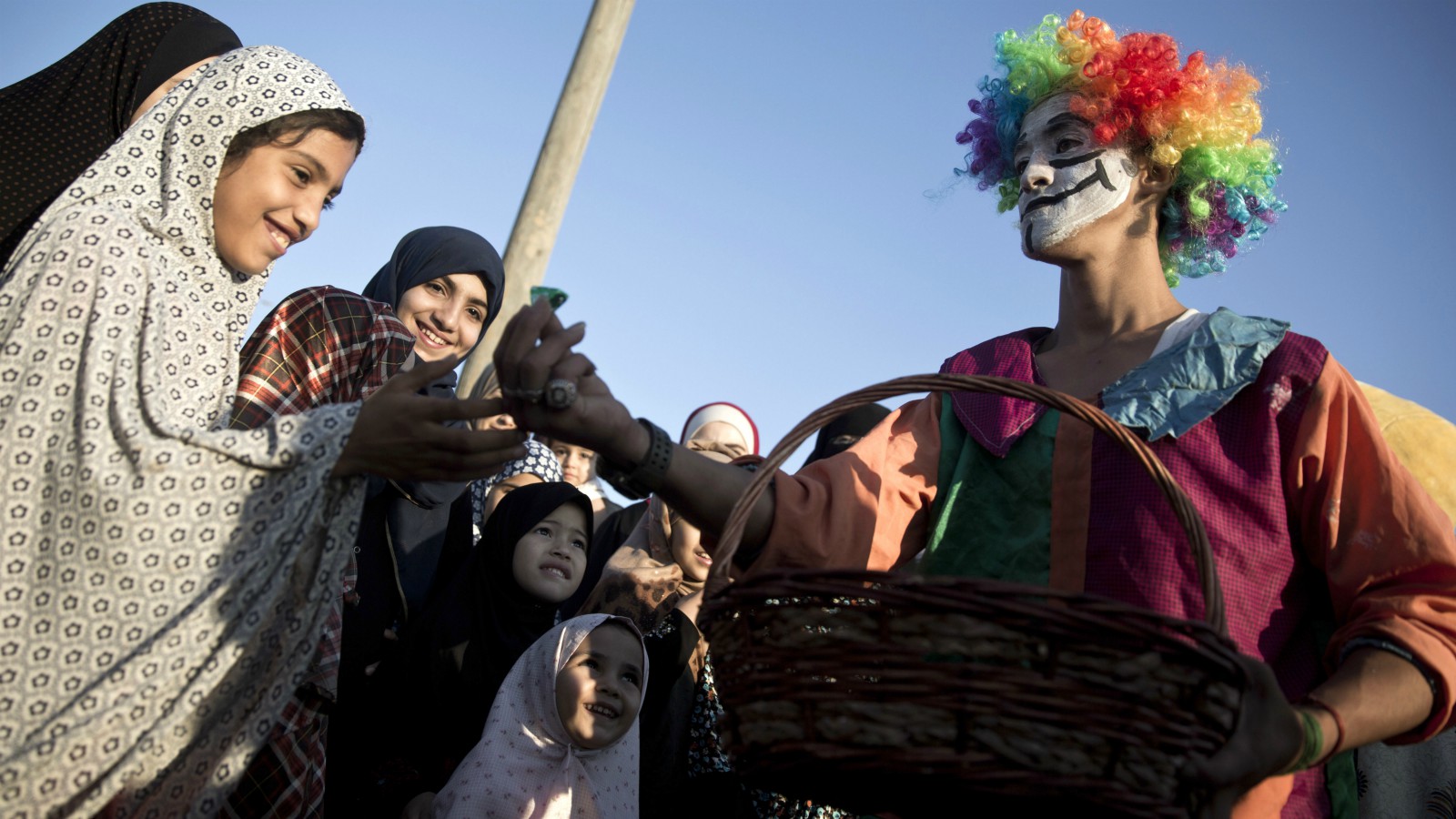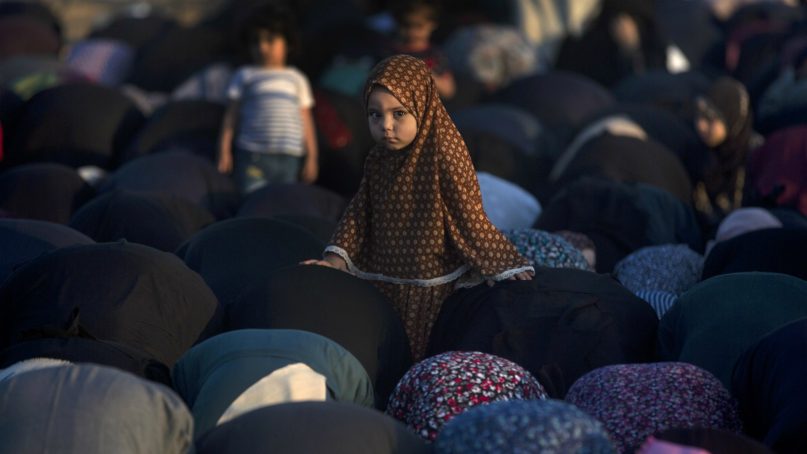GAZA CITY, Gaza Strip (AP) — Gaza worshippers knelt on prayer rugs spread on sandy soil, near the perimeter fence with Israel, joining hundreds of millions of Muslims around the world Friday in marking the holiday that caps the fasting month of Ramadan.
The three-day Eid al-Fitr holiday is typically a time of family visits and festive meals, with children getting new clothes, haircuts and gifts. In the Middle East, celebrations were once again marred by prolonged conflict in hot spots such as Syria, Afghanistan and Yemen.
In the Gaza Strip, some worshippers performed the traditional morning prayers of the holiday in areas several hundred meters (yards) away from the heavily guarded fence with Israel.

A Palestinian man wears as a clown presents candy to Muslim girls attend the Eid al-Fitr prayers marking the end of the holy fasting month of Ramadan, in Eastern Gaza City, Friday, June 15, 2018. (AP Photo/Khalil Hamra)
Friday’s prayers marked the continuation of weeks-long protests against a blockade of Gaza, imposed by Israel and Egypt after the 2007 takeover of the territory by the Islamic militant group Hamas. Since late March, more than 120 protesters have been killed and more than 3,800 wounded by Israeli army fire in the area of the fence.
Ismail Haniyeh, the top Hamas leader, joined worshippers in an area east of Gaza City. At one point, as the faithful bowed their heads on their prayer mats in unison, a young man on crutches — presumably injured in previous protests — followed the ritual while he remained standing. Some activists later approached the fence, burning tires.
Protest organizers said they planned to release large numbers of kites and balloons with incendiary materials rags throughout the day Friday, in hopes they will land in Israel. Such kites with burning rags attached have reportedly burned hundreds of acres of crops and forests in Israel.
Protest organizer Mohammed al-Tayyar, a member of a group calling itself the “burning kites unit,” said Friday larger balloons with greater potential for damage would be released after 10 days unless the blockade is lifted. Israel’s defense minister has said Israel is determined to stop such kites and balloons.
The protests have been organized by Hamas, but turnout has been driven by growing despair in Gaza about blockade-linked hardships; unemployment now approaches 50 percent and electricity is on for just a few hours every day.
Hamas has also billed the protests as the “Great March of Return,” suggesting they would somehow pave the way for a return of Palestinian refugees and their descendants — about two-thirds of Gaza’s residents — to return to ancestral homes in what is now Israel.
Hundreds of thousands of Palestinians were expelled or fled in the Mideast war over Israel’s 1948 creation.
Haniyeh told reporters after Friday’s prayers, which were also being held outdoors in another location east of the town of Khan Younis, that protests would continue.
He said a recent U.N. General Assembly resolution blaming Israel for the Gaza violence “shows that the marches of return and breaking the siege revived the Palestinian issue and imposed the issue on the international agenda.” The resolution also said Israel had used excessive force against Palestinian protesters.
Israel says it is defending its territory and civilians living near Gaza. It has accused Hamas of trying to use the protests as cover for damaging the fence and trying to carry out cross-border attacks. Israel and Egypt argue that the blockade is needed to contain Hamas which has a history of violence and refuses to disarm.
In Jerusalem, senior Muslim cleric Muhammad Hussein told tens of thousands of worshippers that a plan for an Israeli-Palestinian peace deal, expected to be unveiled by the Trump administration, is unfair and “aims at the liquidation of the Palestinian cause.”
President Donald Trump has promised to negotiate the “ultimate deal” but the plan’s reported, though unconfirmed parameters have been dismissed by the Palestinians as siding with Israel.
The Palestinian issue also loomed large in Iran.
Supreme Leader Ayatollah Ali Khamenei, addressing worshippers Friday, praised citizens for showing up at massive rallies last week in support of the Palestinians on Jerusalem Day. That day was initiated by Iran in 1979 to express support for the Palestinians and oppose Israel.
Iranian President Hassan Rouhani said in an Eid al-Fitr message that he believes the “land of Palestine will be returned to owners of the land with the help if God.”
Iran and Israel are bitter foes.
In Syria, President Bashar Assad attended Eid prayers in the town of Tartous, part of an area that has remained loyal to him throughout seven years of civil war. The coastal region is home to Syria’s minority Alawite population that has been the core of Assad’s support. Assad, an Alawite, traces his family’s origins to Qardaha, a town in the mountains nearby.
Tens of thousands of men from the coastal region are believed to have been killed fighting for the president since 2011, according to Syrian monitoring groups. Assad is now in control of Syria’s largest cities and its coastal region.
In Afghanistan, President Mohammad Ashraf Ghani touted a three-day holiday cease-fire with the Taliban, calling for a longer truce and urging the Taliban to come to the negotiating table.
The Taliban agreed to the cease-fire but leader Haibaitullah Akhunzada reiterated his demand for talks with the U.S. before sitting down with the Afghan government.
(Associated Press writer Karin Laub in Jericho, West Bank and Ian Deitch in Jerusalem contributed reporting.)





